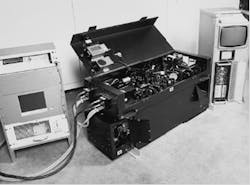Compact airborne lidar system measures methane

An airborne differential absorption lidar (DIAL) system operating at mid-infrared (mid-IR) wavelengths from a relatively small aircraft has been successfully field-tested by engineers at SRI International (SRI, Menlo Park, CA). The system demonstrates that DIAL analysis can detect and measure methane gas plumes downwind of the source at flight altitudes of about 1 km over inhomogeneous surfaces.
Differential absorption lidar systems operate much like single-wavelength backscatter lidar devices but detect and measure remote gas concentrations based on the differences in absorption of laser light at two slightly different wavelengths. For the gas of interest, laser emission wavelengths are spaced such that energy at one wavelength is absorbed significantly more than at the other. The wavelength that is not absorbed can measure the density of atmospheric aerosols and molecules as in a standard lidar system (see Laser Focus World, April 1995, p. 87), while the other wavelength is transmitted, scattered, and received in a similar manner, but its strength is attenuated by absorption. Assuming other factors affecting laser propagation at the two wavelengths are equivalent or can be corrected for, the ratio of the two lidar backscatter signatures provides target gas concentration.
Existing mid-IR DIAL research systems based on Nd:YAG-laser-pumped optical parametric oscillators (OPOs) have successfully detected atmospheric levels of light hydrocarbons with strong absorption lines in the 3- to 5-µm wavelength range. The size, weight, and performance of such systems, however, has generally precluded their routine use for environmental monitoring. In an urban setting, relatively small aircraft are typically used for regional environmental investigations. Hence, a compact, lightweight DIAL system with a small footprint would be attractive for routine operation.
System configuration
The DIAL system developed at SRI fits into a Beechcraft Queen Air aircraft (see Fig. 1). It operates in the 3-µm wavelength region, uses less than 3 kW of electrical power, weighs 245 kg, and has a footprint of less than 1 m2. The transmitter/receiver module includes a pair of KTP-based OPOs pumped by two custom-designed Nd:YAG lasers from Big Sky Laser Technology (Bozeman, MT). This configuration provides about 10 mJ of 3-µm output (see Fig. 2).Pump laser energy to the OPOs is controlled by a combination of a thin-film polarizer, half-waveplate, and neutral density attenuator. A down-collimating telescope is used to increase the energy density incident on the OPOs. Residual 1.06-µm pump-laser output is used as a source for a backscatter lidar that provides range-resolved data on aerosol plume geometry.
During operation the lasers are running continuously at full power to provide a minimum 10-ns pulse width with good shot-to-shot energy stability. To conserve both space and power the laser heads are connected by separate pulse-forming networks derived from a common power supply. Microprocessors control the pulse timing as well as other aspects of laser operation. The reflected lidar signals are collected by a 14-in. Dall-Kirkham afocal telescope comprising an ellipsoid primary and a 1-in. spherical convex secondary.
To collect the methane data, a test flight was conducted by SRI researchers at cattle-feed lots near Kettleman, CA. The lasers were tuned to wavelengths of 3.313 and 3.309 µm. No ground returns were received from the 3.313-µm high-absorption on-line even though the energy was equivalent to that of the off-line at 3.309 µm. Tuning the laser slightly off the absorption line, however, resulted in a relatively good ground return signal, which indicated a high level of ambient methane in the area. Real-time data indicated that a methane plume was detected downwind of the stockyard, and processed data provided its vertical integrated concentration.
Knowledge gained by these limited qualitative experiments, according to Norman B. Nielsen of SRI, is being used to design system improvements that should lead to an operational system for quantitative environmental investigations.
About the Author
Stephen G. Anderson
Director, Industry Development - SPIE
Stephen Anderson is a photonics industry expert with an international background and has been actively involved with lasers and photonics for more than 30 years. As Director, Industry Development at SPIE – The international society for optics and photonics – he is responsible for tracking the photonics industry markets and technology to help define long-term strategy, while also facilitating development of SPIE’s industry activities. Before joining SPIE, Anderson was Associate Publisher and Editor in Chief of Laser Focus World and chaired the Lasers & Photonics Marketplace Seminar. Anderson also co-founded the BioOptics World brand. Anderson holds a chemistry degree from the University of York and an Executive MBA from Golden Gate University.
